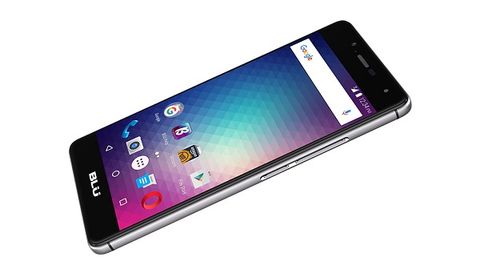

Its one added frill is a small front-facing LED flash for the front camera, which helps the grainy 5MP camera take selfies in dark rooms. This is the baseline smartphone experience, albeit not a bad one.
#Blu r1 hd battery size android
Many Android phones have fingerprint readers or waterproofing or some other extra features that I’d have talk about at this point, but the R1 HD can’t afford them.

In bright light, visible digitizers can give the impression that the screen has small dots or lines all over it in. I had no problem with the responsiveness of the touchscreen, though, as is often the case with cheaper phones, the digitizer is faintly visible.
#Blu r1 hd battery size 720p
The color, contrast, and viewing angles of the R1’s bright 720p LCD display are all pleasant surprises. Even if you pay the full, unsubsidized $110 asking price, you get a phone that has no business looking or feeling as good as it does. The phone is light enough to be comfortable but has the reassuring heft of a well-made piece of consumer technology. The plastic doesn’t creak or flex, and the volume rocker and power button aren’t loose or jiggly. A single rear-facing speaker on the back of the phone kicks out tinny, sort-of-distorted sound at a respectable volume.įit and finish is generally excellent. A small camera bump on the back makes the phone a little wobbly if you’re trying to use it while it’s sitting on a table or desk, but the R1 is large enough that wobbliness is not a huge problem. The front and back of the phone are curved just enough to make the R1 relatively easy to hold in one hand (a 5-inch phone is what passes for “small” among Android phones these days). There’s a headphone jack on the top of the phone, micro USB port (not Type-C, which has yet to migrate to most mid- and low-end Android phones) on the bottom, and a volume rocker and power button on the right side. And though you could probably take the phone apart and replace the battery if you were determined to do it, it’s not designed to be easily removed or replaced.

The SIM trays and SD card slot apparently don’t support hot-plugging, so if you put in a new SIM or card, the phone won't see them until you reboot it. The latter feature is usually removed from the US versions of phones, but it’s present and apparently fully functional here.

Pry off its rubberized plastic back to reveal its microSD card slot and dual SIM trays. It’s a black-and-grey rectangle with rounded edges, a glass front, and plastic sides. Drops to $50/60 respectively with Amazon Prime Special Offers. A nice-looking $60 phone Specs at a glance: BLU R1 HDĨGB or 16GB NAND flash, expandable via microSDīand 12 will be supported in a future OTA update.ĨMP rear camera, 5MP front camera with LED flashĥ.65" x 2.83" x 0.34" (143.5 x 72 x 8.7mm) It’s not a great phone, but it’s a lot of phone for the money. More interesting to bargain hunters, though, is the BLU R1 HD, a phone you can get for $50 with 8GB of storage and 1GB of RAM or $60 with 16GB of storage and 2GB of RAM.īLU (which is short for “Bold Like Us,” so let’s just stick to BLU) has been in the low-end smartphone market for a while now, but just as the original Moto G redefined what you should expect for less than $200 back in 2013, the R1 HD is redefining what you should expect to get for less than $100. One of the “Prime Exclusive” models on offer is the Moto G4, which sell for $150 or $180 depending on the configuration.
#Blu r1 hd battery size trial
In exchange, buyers get a $50 discount on a handful of already-inexpensive phones, assuming they’re already paying $99/year for an Amazon Prime subscription (one could conceivably skirt this requirement by signing up for a Prime trial and then canceling).Īmazon still gets most of the benefits it would have gotten from Fire Phone buyers-a bunch of miniature billboards and a collection of preinstalled apps that point customers to other Amazon apps and services-but it doesn’t have to do as much work to get those results. Until now.Īmazon is getting back into smartphones, but instead of dumping money into R&D and maintaining its own forked OS and ecosystem, the company is taking a page from its e-readers by slapping ads and preinstalled apps onto existing budget-friendly phones. Talk of a follow-up phone persisted for a while, but no phone ever surfaced. The Fire Phone's reputation was mostly deserved-Amazon’s fork of Android cut it off from the Google Play ecosystem, and its hardware was built around a couple of gimmicks that didn’t actually address actual needs. Amazon took a $170 million write down on unsold inventory and contracts with its suppliers, and the phone’s $649 starting price tumbled below $200 in just four months. Further Reading Review: Without quick updates the Moto G4 is merely good, not greatĪmazon’s Fire Phone was, by any reasonable metric, a colossal failure.


 0 kommentar(er)
0 kommentar(er)
